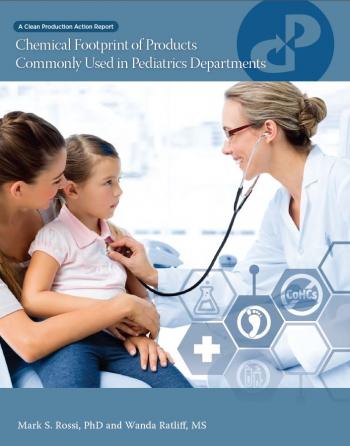What is the Chemical Footprint of Health Care Products?

Nonprofit Clean Production Action Evaluates Products Commonly Used in Pediatric Patient Rooms for Hazardous Chemicals
“This first chemical footprint of products used in pediatric patient rooms demonstrates how health care organizations can measure their chemical footprint at the departmental level and how it can inform purchasing decisions,” highlighted Mark S. Rossi, PhD, lead author and Executive Director of Clean Production Action. The report evaluated four categories of products commonly found or used in a pediatrics patient room: medical supplies, personal care products, furniture and furnishings, and cleaning and disinfecting products.
Kyle Tafuri, Director of Sustainability at Hackensack-Meridian Health explained, “having chemical footprint data reveals where CoHCs are in products, which in turn helps us make better purchasing decisions that advance our mission of health.”The results included:
- Slightly less than half (45%) of the 253 products evaluated contained one or more chemical of high concern (CoHC) to human health and the environment. The CoHCs reported in products included polyvinyl chloride (PVC) plastic, phthalates, Bisphenol A (BPA), and other carcinogens and reproductive toxicants identified by California Proposition 65 (“Prop 65”).
- Intravenous (IV), enteral feeding, and respiratory therapy products were the medical supplies with the greatest number of products containing CoHCs.
- A number of products – including enteral feeding tubes and all the personal care products – featured one or more supplier selling one product with CoHCs while another supplier sold a comparable product without CoHCs.
Where do we go from here?
With chemical footprint data in hand, health care organizations can measure their progress in reducing their footprint. For example, if health care suppliers eliminated PVC and its associated CoHCs from the medical supplies reviewed in this survey, health care organizations would eliminate 75% of the CoHCs in medical supplies.
# # #
About chemical footprinting
“Chemical footprinting” is the process of evaluating the presence of hazardous chemicals in products, manufacturing processes, supply chains, and/or packaging. Chemical footprints provide baseline data, be they the number of chemicals of high concern in products and/or their mass, for evaluating performance and benchmarking progress away from hazardous chemicals to safer alternatives. For this study, the chemical footprint of a pediatric product was defined by the presence of chemicals of high concern in a product.
About Clean Production Action
Clean Production Action’s mission is to design and deliver strategic solutions for green chemicals, sustainable materials, and environmentally preferable products. Our tools simplify the complexity of reducing the chemical footprint of hazardous chemicals. Our collaborations provide effective platforms for practitioners and thought leaders to work together in advancing safer chemicals and healthy materials. Business, non-profit, investment, government, and academic leaders are using our tools – GreenScreen and Chemical Footprint Project – and engaging in our BizNGO collaboration to create a safer and healthier tomorrow for people and the planet.

